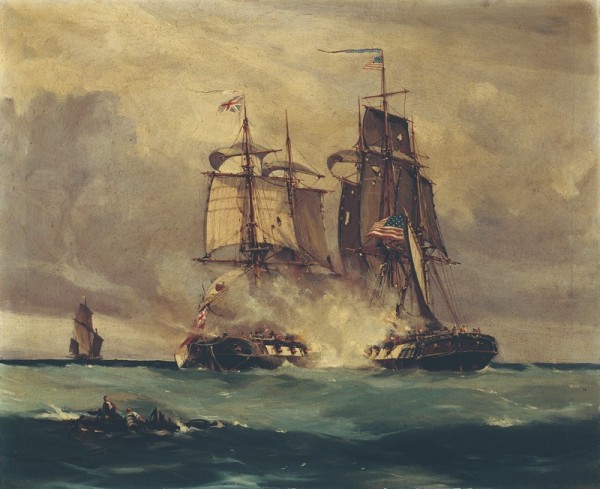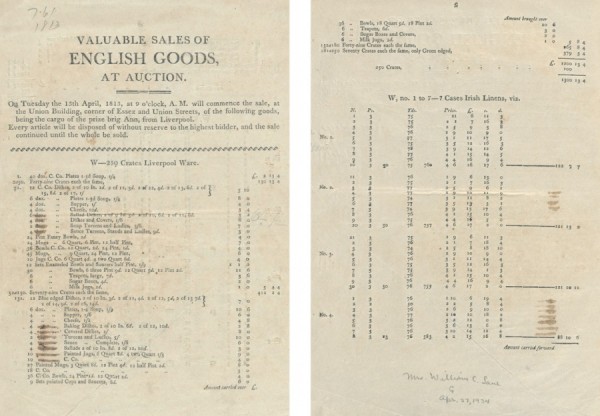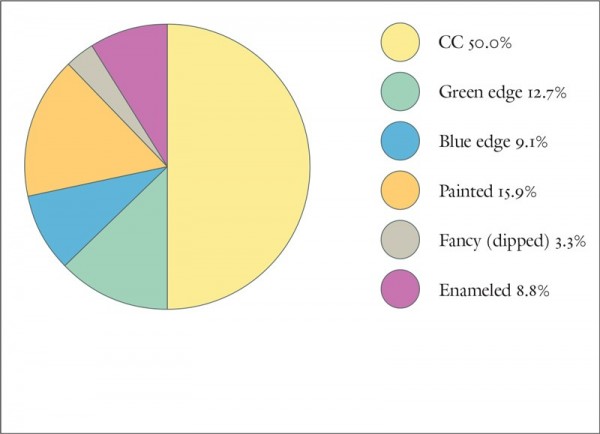
Thomas Whitcombe (English, ca. 1760–1824), Battle Scene in the English Channel between American Ship “Wasp” and the English Brig “Reindeer,” 1812. Oil on canvas, 30" x 20". (George F. Harding Collection, The Art Institute of Chicago.)

Two pages from the auction catalog. (Courtesy, Kress Library of Business and Economics, Baker Library, Harvard Business School.)

Fascimile of auction announcement in Essex Register (Salem, Mass.), April 10, 1813 (vol. 13, no. 29), p. 3 (transcribed by the author).

Percentage of assemblage by type of vessel.

Types of decoration on the 109,240 vessels auctioned from the prize brig Ann.
On April 13, 1813, 250 crates of “Liverpool Ware” and 7 cases of “Irish Linens” were auctioned in Salem, Massachusetts. These were the cargo from the prize brig Ann that had been captured by Captain Nathan Lindsey of the privateer schooner Growler. Following the sale of the cargo, the prize ship—described as “The Brigantine ANN, of the burden of 226 tons or thereabouts together with her tackle, apparel and furniture; also three pair of 9 pound Cannonades”—was auctioned off as well.[1] Prize auctions were common in the War of 1812; what makes this one of great interest is the survival of the auction catalog, in the Kress Collection of the Baker Library of the Harvard University Business School.
During the War of 1812, the United States government issued letters of marque to more than five hundred privateers who captured about thirteen hundred English commercial vessels.[2] Letters of marque authorized private, armed vessels to capture vessels of the enemy (fig. 1). In some cases, the cargo was seized and the prize ship was burned. If the captured ship was worth taking back to port and the privateer had enough men to spare, it was declared a prize of war to be sold or auctioned off. The proceeds were divided among the owners of the privateer vessel who financed the venture, the captain, and the crew, based on the contracted number of shares assigned to each.
The Growler was based in Salem, Massachusetts. In a discussion of the War of 1812 in his History and Traditions of Marblehead, Samuel Roads Jr. states:
As soon as the news of the declaration of war was received in Marblehead . . . four privateers, namely, the Lion, the Thorn, the Snowbird, and the Industry, were immediately fitted out, and began a series of remarkable successful Cruises against the ships of the British nation.
This is not all. Forty private armed schooners were soon fitted out in Salem....One Schooner, the Growler, was commanded by Capt. Nathaniel Lindsey, of Marblehead, and had an entire crew of Marblehead men.[3]
Roads further reports that the Growler “captured the brig Ann, of ten guns bound from Liverpool to New Providence, richly laden with dry goods and crates worth $100,000.”[4]
A newspaper from March 6, 1813, announced:
Yesterday arrived at Marblehead, the British brig Ann, (capt. Joseph L. Lee, prize master) from Liverpool bound to N. Providence, with a cargo of dry goods & crates, valued at 80 to 100,000 dollars—She was captured above [sic] 70 days since by the private armed scho. Growler, of this port.[5]
This notice suggests that the brig Ann was captured in late December 1812. Just seven months later, on July 7, 1813, the Growler itself became a prize of war when it was captured near Newfoundland after a six-hour chase by His Majesty’s brig Electra, under Commander William Gregory. The Growler was described as
pierced for 14 guns but carrying one long 24-pounder gun and four 18-pounder guns. She had a crew of 60 men. Growler, under Captain N. Lindsey, had had a relatively successful cruise having taken the ship Arabella, a brig, the schooner Prince of Wales, and the brig Ann. . . . The prize money for Gregory was £64 5s, and for an ordinary seaman on Electra it was £1 4s 9d.[6]
The auction catalog for the brig Ann lists 250 crates of ceramics that fall into four basic assortments (fig. 2). Each type of crate is enumerated in great detail, followed by the number of crates that contain the same assortment of vessels. Crate 1, for example, is described as having “40 doz. C. Co. Plates 1-3d Soups 1/4,” followed by a note stating that each of crates 2 through 50 had the same contents as crate 1. The other three assortments are described similarly but in much more detail, since they include a greater variety of vessel shapes and decoration types (enumerated in Tables 3–5). What follows these listings is a minimal description of the seven crates of Irish linens from the cargo; they are more fully described in the April 7, 1813, auction advertisement published in the Essex Register (fig. 3).
The description of the ceramics follows the format of invoices used for ceramics shipped from Staffordshire to the American market, which suggests that the catalog was transcribed from a potter’s invoice. Unfortunately, the name of the factory or factories that produced the wares and the designated recipient of the shipment were not recorded. The prices listed for each lot would also have been taken from the potter’s invoice. Prices for “Dishes” (a potter’s term for platters) are nearly identical to those in the 1796 and 1814 Staffordshire price-fixing lists, whereas the price of plates is slightly lower (see Table 1).[7] Unfortunately, the prices realized for each lot are not recorded in the catalog.
Descriptions of the Four Crate Assortments
The assortment for crate 1 was listed as “40 doz. C. Co. Plates 1/3d Soup 1/4 £ 2/13/4 [sic].” These were cream-colored (CC) plates, of which one-quarter were soup plates. The total price of £ 2/13/4 is an error, as it was calculated by multiplying the 40 dozen by the 1-to-4 mix ratio, rather than by the 1/3d (1 shilling 3 pence), which was the price. The breakdown is given in Table 2.
Crates 2 through 50 were of the same mix of CC plates as in crate 1, bringing the total to 18,000 plates and 6,000 soup plates—24,000 vessels in all. The average cost per vessel was 1.25 pence.
Crate 51 contained an assortment of mostly creamware vessels (enumerated in Table 3). This would have been known as an “assorted crate,” meaning it was offered for sale to merchants as a unit only, rather than by the item.
Crates 52–130 are listed as containing the same mix of 455 vessels enumerated in crate 51. In short, there were 80 crates containing the assemblage listed for crate 51, for a total of 36,400 vessels. The average cost of these vessels was 2.7 pence. The auction catalog lists crate 51 as being worth £5/4/4, but by my calculations in Table 3 it totals £5/3/10, suggesting a math error in the original tally.
Crate 131 is another assorted crate, and lists a large number of blue-edged vessels, which are enumerated in Table 4. This crate contained 407 vessels and was valued at £5/8/4, for an average value of 3.2 pence.
Crates 132 through 180 were listed as containing the same assemblage as that enumerated in crate 131, so there were 50 crates of blue shell-edged and other wares, for a total of 20,350 vessels.
Crate 181 through 250 contained the same assortment of 407 vessels as enumerated for crate 131, but the wares were green shell-edged rather than blue shell-edged, bringing to 70 the total number of crates with green-edged wares, or 28,490 vessels.
A summary of all of the forms, decorative types, and quantities contained in the crates is presented in Table 5.
Table 6 illustrates the percentages and ratios of wares by functional groupings by combining the number of vessels by their decorative types from all the crates. This is followed by figure 4, a pie chart of the distribution of the 109,240 vessels grouped by vessel type.
The combined assemblage appears to have had very limited numbers of teawares and no toilet wares (chamber pots, ewers, basins). However, the fifty crates of CC plates have distorted the assemblage toward those vessels. Table 7 provides a list of the vessel types in the crates that have assorted assemblages. Teawares still make up a smaller proportion of the assemblages than expected, and no toilet wares are listed.
CC ware (plain creamware) is the dominant type of the 109,240 vessels from the brig Ann cargo. The second most-common type of ware is painted, followed by green-edged, blue-edged, enameled (overglaze painted), and “fancy” (dipped). No printed wares are listed in any of the assorted crates. The decorated wares listed, with the exception of the enamel painted, are the cheapest available with color decoration. Figure 5 shows the breakdown of the decorative types in the assemblage.
There are major differences among the types of decoration present on tea-, table-, and hollow wares. For example, all of the teaware is decorated. All the cups and saucers are painted. Teapots, sugar boxes, and milk jugs are either painted or enameled. Tableware (dishes, plates, and serving vessels) are in CC ware, blue edged, or green edged. Bowls are in CC ware, fancy (dipped), painted, or enameled decoration. Mugs are in CC ware, fancy (dipped), or painted decoration. Jugs are CC ware or painted.
Observations on the 250 Crates of Assorted Ware
Table 8 is a summary of the total cost of the ceramics in the 1813 auction catalog. The summary of the value of the crates of earthenware in the 1813 auction catalog was listed as £1,300/13/4, which is close to the calculations in Table 8. Dividing the $5,567.77 by the 109,240 vessels yields an average value of five cents per vessel. The value of the pound sterling for these calculations was taken from value of the dollar from the exchange rates of 1816.[8]
The total value of the ceramics is far short of the estimated value of the prize, which in the newspaper announcement of March 6, 1813, was between $80,000 and $100,000. The value of the textiles came to £5,543/9/8.5, which in the 1816 exchange rate of the dollar was $25,333.73. Thus the value of the ceramics was only 18 percent of the cargo and the textiles was 82 percent of the cargo. Together they came to $30,901.50, which was well below the estimated value of the prize. Clearly, the estimate of the value of the prize included the value of the brig Ann. Unfortunately, we do not know the prices realized; a follow-up newspaper article on the auction is not known. One would assume that the English ceramics and textiles brought a premium price during the War of 1812, when the supply of them was limited to prizes taken for auction. In addition, the currency was inflated by the War of 1812, which makes the question of prices difficult to answer.
All of the assorted crates of CC, blue-edged, and green-edged wares included other types of decorated vessels. Assorted crates have a long history in the pottery industry. By the late eighteenth century, merchants specializing in ceramics and glass took special orders made up of the vessels wanted by retail merchants.[9] Assorted crates represent what the potter or wholesaler thought would be a marketable assemblage to retailers. The assorted crates described above are unusual in the relatively small percentage of teawares included. For example, the CC crates did not include any cups and saucers.
The Market for English Ceramics in 1813
Napoleon’s 1806 Berlin Decree cut off the European Continental market for British products, and this, followed by the American Embargo of 1807, the Non-Importation Act, and the War of 1812, eliminated the important American market for English manufactured goods. The many American privateers preying on English ships aggravated the economic situation. The South American market was opening because of the revolutions for independence that took place while French and English armies occupied Spain. The Caribbean market was open, but dangerous because of the privateers.
The brig Ann is listed as having sailed out of Liverpool for New Providence, the main island of Bermuda. It was probably headed for St. George, the main port town on the island. Following the American Revolution, it is estimated that eight thousand loyalists from the American South, including plantation owners and their slaves, immigrated to Bermuda. The population of the islands tripled, three-quarters being slaves.[10] During the Napoleonic Wars the British built a complex of military forts and a naval dockyard.[11] Military operations provided a cash inflow to Bermuda and provided employment for many on the islands. Many prize ships captured by British privateers out of Bermuda and by the British Navy wound up being auctioned off in Bermuda during the Napoleonic Wars and the War of 1812.[12] These activities and Bermuda’s history as a center for illicit trade help to explain why the prize brig Ann would be headed there when the European continent and the American markets were closed off to the British.
The presentation of the auction record of the brig Ann’s cargo offers a rare glimpse into the tremendous quantities of the standard tablewares produced by the English potters and imported into this country during its formative years.
Advertisement from the Essex Register, Salem, Massachusetts, April 7, 1813.
American Merchant Marine and Privateers in the War of 1812, at www.usmm.org/warof1812.html (accessed April 29, 2012).
Samuel Roads, The History and Traditions of Marblehead (Boston: Houghton, Osgood and Co., 1880), p. 242.
Ibid., p. 246.
Essex Register, March 6, 1813, p. 3.
London Gazette, March 6, 1815, p. 425; see also Edgar Stanton Maclay, A History of American Privateers (New York: D. Appleton and Co., 1899). For more about the Electra, see http://en.wikipedia.org/wiki/HMS Electra_(1808) (accessed October 26, 2012).
The 1796 Staffordshire potter’s price-fixing list is reproduced in Arnold R. Mountford, “Documents Related to the English Ceramics of the 18th & 19th Centuries,” Journal of Ceramic History 8 (1975): 11. The 1814 list is reproduced in George L. Miller, “George M. Coates, Pottery Merchant of Philadelphia, 1817–1831,” Winterthur Portfolio 19, no. 1 (Spring 1984): 42–43.
Oscar G. Schilke and Raphael E. Solomon, America’s Foreign Coins: An Illustrated Standard Catalogue with Valuations of Foreign Coins with Legal Tender Status for the United States, 1793–1857 (New York: Coin and Currency Institute, 1964).
For an example of such a merchant, see Arlene Palmer Schwind, “The Ceramic Imports of Frederick Rhinelander, New York Loyalist Merchant,” Winterthur Portfolio 19, no. 1 (Spring 1984): 21–36.
Michael Craton, A History of the Bahamas, 2nd ed. (London: Collins, 1968), pp. 162–65.
Michael Jarvis, In the Eye of All Trade: Bermuda, Bermudians and the Maritime Atlantic World, 1680–1783 (Chapel Hill: University of North Carolina Press, 2010), pp. 455–57.
Henry C. Wilkinson, Bermuda from Sail to Steam: The History of the Island from 1784 to 1901, 2 vols. (London: Oxford University Press, 1973), 1: 323–26.
